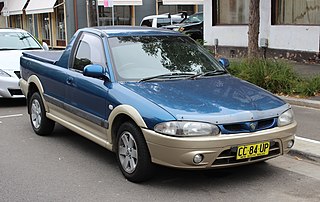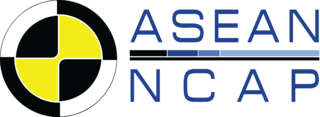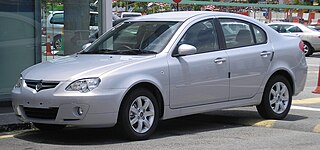
Proton Holdings Berhad, commonly known as Proton, is a Malaysian multinational automotive company. Proton was established on May 7, 1983, as Malaysia's sole national budget car company until the advent of Perodua in 1993. The company is headquartered in Shah Alam, Selangor, and operates additional facilities in Proton City, Perak.

The Proton Waja is a saloon car manufactured by Malaysian automotive company, Proton, it was launched in May 2000 by fourth Prime Minister Mahathir Mohamad.

The Proton Saga is a series of subcompact cars and currently city cars produced by Malaysian automobile manufacturer Proton. Introduced in 1985, the Proton Saga became the first Malaysian car and a major milestone in the Malaysian automotive industry. The Saga is Proton's longest-running and best-selling nameplate, with over 1.9 million units sold worldwide over 37 years.

The Proton Arena is a small front wheel drive coupé utility manufactured by Malaysian automaker Proton. Introduced in 2002, the Arena is the only form of pickup by Proton, and is the only Proton model to enjoy significantly more popularity in its export market than domestically.

The Proton CamPro engine is the first flagship automotive engine developed together with Lotus by the Malaysian automobile manufacturer, Proton.

The Proton Persona is a series of compact and subcompact cars produced by Malaysian automobile manufacturer Proton.

The Proton Juara is a microvan/mini MPV produced by the Malaysian automobile manufacturer Proton between 2001 and 2004. It was launched on 22 July 2001 as Proton’s first non-saloon, hatchback or coupé model. The Juara was to be jointly developed by Proton and Mitsubishi Motors as an export model under the Mitsubishi badge. However, its poor reception and slow sales led to an early end to its production in 2004.
The Australasian New Car Assessment Program (ANCAP) is a car safety performance assessment programme based in Australia and founded in 1993. ANCAP specialises in the crash testing of automobiles sold in Australia and the publishing of these results for the benefit of consumers. ANCAP provides consumers with transparent advice and information on the level of occupant and pedestrian protection provided by different vehicle models in the most common types of crashes, as well as their ability—through technology—to avoid a crash.

The Proton Exora is a discontinued automobile produced by the Malaysian car manufacturer Proton. Considered to be a compact multi-purpose vehicle (MPV) in the C-segment, it became Malaysia's first locally developed MPV upon its release on April 15, 2009. The Exora is the first Proton based on the P2 platform. Its facelift revision, which debuted on December 15, 2011, became the first Proton to use the CamPro CFE turbocharged engine and CVT technology.

The Proton Prevé is a four-door compact saloon developed by Malaysian automobile manufacturer Proton. It was launched on 16 April 2012 and is based on Proton's next-generation P2 platform. The Prevé is the saloon complement to its sister car, the Proton Suprima S hatchback, and is also the successor of Proton Inspira.

The New Car Assessment Program for Southeast Asia, or known as ASEAN NCAP, is an automobile safety rating program jointly established by the Malaysian Institute of Road Safety Research (MIROS) and Global New Car Assessment Program upon a collaborative MoU signed by both parties during the FIA Foundation Annual General Assembly in New Delhi, India on 7 December 2011.

The Proton Suprima S, codenamed P3-22A is a five-door compact hatchback engineered by Malaysian automobile manufacturer Proton. It was released on 17 August 2013 and is based on Proton's next generation P2 platform. The Suprima S complements the Proton Prevé saloon and has been designed with larger emphasis on international markets.

The Proton Iriz is a supermini (B-segment) produced by Malaysian automobile manufacturer Proton since 2014. It was unveiled on 25 September 2014 at Proton City by the fourth and seventh Malaysia's prime minister, Dr. Mahathir Mohamad. The Iriz platform is also used by its sedan equivalent, the Persona (BH) which was introduced in 2016.

The second-generation Proton Persona (CM) is a C-segment saloon produced by the Malaysian automobile manufacturer Proton. The CM series represents the second generation in the Proton Persona lineage, and the first Proton model to use the 'Persona' nameplate in its home market. It was unveiled on 15 August 2007 as the successor to the Proton Wira in Malaysia, and the C90 Persona in its export markets.

The third-generation Proton Persona (BH), codenamed P2-31A during development, is a subcompact (B-segment) saloon engineered by the Malaysian automobile manufacturer Proton. The BH series represents the third and latest generation in the Proton Persona lineage. It was unveiled on 23 August 2016 as the successor to the CM Persona.

The third generation Proton Saga, codenamed P2-13A is an A-segment saloon engineered by Malaysian automobile manufacturer Proton. It was launched on 28 September 2016 as the successor to the second generation Proton Saga.

Milo tin is a Malaysian pejorative used to describe unsafe or cheaply made vehicles. It is comparable to the slang term, 'deathtrap'.

The Proton X70 is a compact crossover SUV produced by the Malaysian car maker Proton. Marketed as a C-segment SUV, the car was launched on 12 December 2018, unveiled in a ceremony by then-prime minister and former Proton chairman Mahathir Mohamad. Being the first SUV released by Proton, it is conceived by rebadging the Geely Boyue, following the acquisition of Proton by Geely Automobile Holdings in 2017. The X70 is distinguishable from the Boyue by some design element differences and its right-hand drive configuration.

The Proton X50 is a subcompact crossover SUV produced by the Malaysian car maker Proton. Marketed as a B-segment SUV, the vehicle was revealed on 15 September 2020 and was launched on 27 October 2020. The model is the second SUV from the brand after the X70. The vehicle is a rebadged Geely Binyue with several changes, including the right-hand drive conversion and several mechanical adjustments.

The Proton S70 is a compact sedan produced by Malaysian automobile manufacturer Proton. The vehicle was previewed on 20 November 2023, as it is marked the first sedan car produced by Proton following the 49.9% share acquisition by Geely in 2017. The S70 is the successor to the Proton Prevé.


















